Microstructure and Thermal Deformation Behavior of Hot-Pressing Sintered Zr-6Al-0.1B Alloy
Abstract
:1. Introduction
2. Materials and Methods
2.1. Preparation of Zr-6Al-0.1B Alloy
2.2. Isothermal Compression Tests
3. Results and Discussion
3.1. Microstructure of Sintered Zr-6Al-0.1B Alloy
3.2. Thermal Deformation Behavior of Sintered Zr-6Al-0.1B Alloy
3.3. Microstructure Evolution of Sintered Zr-6Al-0.1B Alloy
4. Conclusions
Author Contributions
Funding
Institutional Review Board Statement
Informed Consent Statement
Data Availability Statement
Conflicts of Interest
References
- Xie, Y.; Yang, S.; Dai, S.; Lu, Z. Mechanical properties and strengthening mechanism of aluminum alloys containing zirconium. Chin. J. Nonferrous Met. 2003, 13, 1192–1195. (In Chinese) [Google Scholar]
- Helmi Attia, M. On the fretting wear mechanism of Zr-alloys. Tribol. Int. 2006, 39, 1320–1326. [Google Scholar] [CrossRef]
- Wei, K.; Qu, Y.; Li, J.; Chen, L.; Du, J.; Xue, W. Surface charge and corrosion behavior of plasma electrolytic oxidation film on Zr3Al based alloy. Surf. Coat. Tech. 2019, 357, 412–417. [Google Scholar] [CrossRef]
- Fecht, H.J.; Han, G.; Fu, Z.; Johnson, W.L. Metastable phase formation in the Zr-Al binary system induced by mechanical alloying. J. Appl. Phys. 1990, 67, 1744–1748. [Google Scholar] [CrossRef] [Green Version]
- Ma, E.; Atzmon, M. Calorimetric evidence for polymorphous constraints on metastable Zr-Al phase formation by mechanical alloying. Phys. Rev. Lett. 1991, 67, 1126. [Google Scholar] [CrossRef] [PubMed]
- Zhao, S.Z.; Li, J.H.; Liu, B.X. Local structure of the Zr-Al metallic glasses studied by proposed n-body potential through molecular dynamics simulation. J. Mater. Res. 2010, 25, 1679–1688. [Google Scholar] [CrossRef]
- Du, J.; Wen, B.; Melnik, R.; Kawazoe, Y. Cluster characteristics and physical properties of binary Al-Zr intermetallic compounds from first principles studies. Comp. Mater. Sci. 2015, 103, 170–178. [Google Scholar] [CrossRef]
- Mohammadi, A.; Enikeev, N.A.; Murashkin, M.Y.; Arita, M.; Edalati, K. Developing age-hardenable Al-Zr alloy by ultra-severe plastic deformation: Significance of supersaturation, segregation and precipitation on hardening and electrical conductivity. Acta Mater. 2021, 203, 116503. [Google Scholar] [CrossRef]
- Jiang, X.J.; Zhang, Y.Y.; Li, C.L.; Liang, G.D.; Han, R.H.; Zhang, X.Y. Microstructure and mechanical properties of ZrAl binary alloys. J. Alloys Compd. 2019, 811, 152068. [Google Scholar] [CrossRef]
- Li, J.; Mao, L.; Zhang, F.; Wang, Q.; Guo, D.; Ma, J.; Li, Q. Effect of Al content and annealing temperature on phase compositions and mechanical properties of ZrAl Alloys. Rare Metal Mat. Eng. 2014, 43, 2227–2231. [Google Scholar]
- Li, J.H.; Gao, Y.; Liu, S.; Mao, L.; Zhang, F.C.; Li, Q. The effects of alloy composition and annealing time on microstructure and mechanical properties of Zr3Al-based alloys. Mater. Res. Innov. 2015, 19, 55–58. [Google Scholar] [CrossRef]
- Tewari, R.; Dey, G.K.; Banerjee, S.; Prabhu, N. Microstructural evolution in Zr3Al-based alloys during various long-time annealing treatments. Metall. Mater. Trans. A 2006, 37, 49–58. [Google Scholar] [CrossRef]
- Ren, Z.; Xue, Z.; Zhang, X.; Qin, J.; Ma, M.; Liu, R. Atomic diffusion mediated by vacancy defects in L12-Zr3Al: A first-principles study. J. Alloys Compd. 2020, 824, 153223. [Google Scholar] [CrossRef]
- Yuan, X.; Wei, D.; Cheng, Y.; Ji, G.; Zhang, Q.; Gong, Z. Pressure effects on elastic and thermodynamic properties of Zr3Al intermetallic compound. Comp. Mater. Sci. 2012, 58, 125–130. [Google Scholar] [CrossRef]
- Arıkan, N. The first-principles study on Zr3Al and Sc3Al in L12 structure. J. Phys. Chem. Solids 2013, 74, 794–798. [Google Scholar] [CrossRef]
- Knipling, K.E.; Karnesky, R.A.; Lee, C.P.; Dunand, D.C.; Seidman, D.N. Precipitation evolution in Al-0.1Sc, Al-0.1Zr and Al-0.1Sc-0.1Zr (at.%) alloys during isochronal aging. Acta Mater. 2010, 58, 5184–5195. [Google Scholar] [CrossRef]
- Xu, J.; Freeman, A.J. Phase-stability and electronic-structure of ScAl3 and ZrAl3 and of Sc-stabilized cubic ZrAl3 precipitates. Phys. Rev. B 1990, 41, 12553–12561. [Google Scholar] [CrossRef]
- Wang, J.; Zheng, W.; Xu, G.; Zeng, X.; Cui, Y. Thermodynamic assessment of the Ti-Al-Zr system and atomic mobility of its bcc phase. Calphad 2020, 70, 101801. [Google Scholar] [CrossRef]
- Mundhra, G.; Hariharan, V.S.; Murty, B.S. Design of a novel Al-Ti-Zr light-weight alloy: CALPHAD and experiments. J. Alloys Compd. 2020, 835, 155304. [Google Scholar] [CrossRef]
- Sarkar, B.K.; Verma, A.S.; Deviprasadh, P.S. First-principles phase stability calculations of Zr3Al1-xNbx alloys with L12 and DOa Structures. In TMS 2015 144th Annual Meeting & Exhibition; The Minerals, Metals & Materials Society, Ed.; Springer: Berlin/Heidelberg, Germany, 2015; pp. 713–719. [Google Scholar]
- Li, J.H.; Li, Q.; Zhang, F.C.; Liu, S.; Mao, L.; Hu, B.C.; Yang, Z.N. Effects boron on microstructure and mechanical properties of Zr3Al-based alloys. Mater. Lett. 2015, 153, 70–72. [Google Scholar] [CrossRef]
- Ivasishin, O.M. Production of titanium alloys and parts by the economical powder metallurgy method for large-scale industrial applications. Nauka I Innovatsii 2005, 2, 45–57. [Google Scholar]
- Qiu, C.L.; Attallah, M.M.; Wu, X.H.; Andrews, P. Influence of hot isostatic pressing temperature on microstructure and tensile properties of a nickel-based superalloy powder. Mat. Sci. Eng. A 2013, 564, 176–185. [Google Scholar] [CrossRef]
- Sreenu, B.; Sarkar, R.; Satheesh Kumar, S.S.; Chatterjee, S.; Appa Rao, G. Microstructure and mechanical behaviour of an advanced powder metallurgy nickel base superalloy processed through hot isostatic pressing route for aerospace applications. Mat. Sci. Eng. A 2020, 797, 140254. [Google Scholar] [CrossRef]
- Jeevan, V.; Rao, C.S.P.; Selvaraj, N.; Bhaskar Rao, G. Fabrication and characterization of AA6082-ZTA composites by powder metallurgy process. Mater. Tod. Proc. 2018, 5, 254260. [Google Scholar] [CrossRef]
- Kondoh, K.; Fukuo, M.; Kariya, S.; Shitara, K.; Li, S.; Alhazaa, A.; Umeda, J. Quantitative strengthening evaluation of powder metallurgy Ti-Zr binary alloys with high strength and ductility. J. Alloys Compd. 2021, 852, 156954. [Google Scholar] [CrossRef]
- Tang, L.T.; Zhu, D.G.; Sun, Z.; Jiang, X.S.; Song, T.F.; Hu, C.F. Microstructure and mechanical properties of Al-Ti-Zr intermetallic compounds prepared by vacuum hot pressing. Vacuum 2018, 150, 166–172. [Google Scholar] [CrossRef]
- Xu, W.; Lu, X.; Hayat, M.D.; Tian, J.; Huang, C.; Chen, M.; Qu, X.; Wen, C. Fabrication and properties of newly developed Ti35Zr28Nb scaffolds fabricated by powder metallurgy for bone-tissue engineering. J. Mater. Res. Technol. 2019, 8, 3696–3704. [Google Scholar] [CrossRef]
- Ma, G.; Wang, D.; Liu, Z.; Bi, S.; Zan, Y.; Xiao, B.; Ma, Z. Effect of hot pressing temperature on microstructure and tensile properties of SiC/Al-Zn-Mg-Cu Composites. Acta Metall. Sin. 2019, 55, 1319–1328. [Google Scholar]
- Huo, S.; Wang, Y.; Yao, M.; Chen, L.; Kong, Q.; Ouyang, J.; Fu, Y.; Zhou, Y. Reactive sintering behavior and enhanced densification of (Ti,Zr)B2-(Zr,Ti)C composites. J. Eur. Ceram. Soc. 2020, 40, 4373–4380. [Google Scholar] [CrossRef]
- Dekhtyar, A.I.; Bondarchuk, V.I.; Karasevska, O.P.; Oryshych, D.V.; Savvakin, D.G.; Skoryk, M.A. Microstructure change under hot deformation in zirconium alloys synthesized by powder metallurgy. Mater. Charact. 2019, 158, 109949. [Google Scholar] [CrossRef]
- Lakshman, S.V.; Gibbins, J.D.; Wainwright, E.R.; Weihs, T.P. The effect of chemical composition and milling conditions on composite microstructure and ignition thresholds of Al-Zr ball milled powders. Powder Technol. 2019, 343, 87–94. [Google Scholar] [CrossRef]
- Wainwright, E.R.; Weihs, T.P. Microstructure and ignition mechanisms of reactive aluminum-zirconium ball milled composite metal powders as a function of particle size. J. Mater. Sci. 2020, 55, 14243–14263. [Google Scholar] [CrossRef]
- Alatalo, M.; Weinert, M.; Watson, R.E. Stability of Zr-Al alloys. Phys. Rev. B 1998, 57, R2009. [Google Scholar] [CrossRef]
- Kim, Y.; Song, Y.; Lee, S.H.; Kwon, Y. Characterization of the hot deformation behavior and microstructural evolution of Ti-6Al-4V sintered preforms using materials modeling techniques. J. Alloys Compd. 2016, 676, 15–25. [Google Scholar] [CrossRef]
- Li, X.; Liu, C.; Luo, K.; Ma, M.; Liu, R. Hot deformation behaviour of SiC/AA6061 composites prepared by spark plasma sintering. J. Mater. Sci. Technol. 2016, 32, 291–297. [Google Scholar] [CrossRef]
- Sun, F.; Li, B.; Cai, C.; Cai, Q. Effects of TiN nanoparticles on hot deformation behavior of ultra-fine grained Al2024-TiN nanocomposites prepared by spark plasma sintering. Mech. Mater. 2019, 138, 103152. [Google Scholar] [CrossRef]
- Emdadi, A.; Sizova, I.; Bambach, M.; Hecht, U. Hot deformation behavior of a spark plasma sintered Fe-25Al-1.5Ta alloy with strengthening Laves phase. Intermetallics 2019, 109, 123–134. [Google Scholar] [CrossRef]
- Yang, F.; Zhang, D.; Gabbitas, B.; Lu, H.; Wang, C. Microstructural evolution during extrusion of a Ti/Al/Al35V65 (Ti-6Al-4V) powder compact and the mechanical properties of the extruded rod. Mat. Sci. Eng. A 2014, 598, 360–367. [Google Scholar] [CrossRef]
- Yang, F.; Gabbitas, B. Feasibility of producing Ti-6Al-4V alloy for engineering application by powder compact extrusion of blended elemental powder mixtures. J. Alloys Compd. 2017, 695, 1455–1461. [Google Scholar] [CrossRef]
- Singh, A.P.; Yang, F.; Torrens, R.; Gabbitas, B. Solution treatment of Ti-6Al-4V alloy produced by consolidating blended powder mixture using a powder compact extrusion route. Mat. Sci. Eng. A 2018, 712, 157–165. [Google Scholar] [CrossRef]

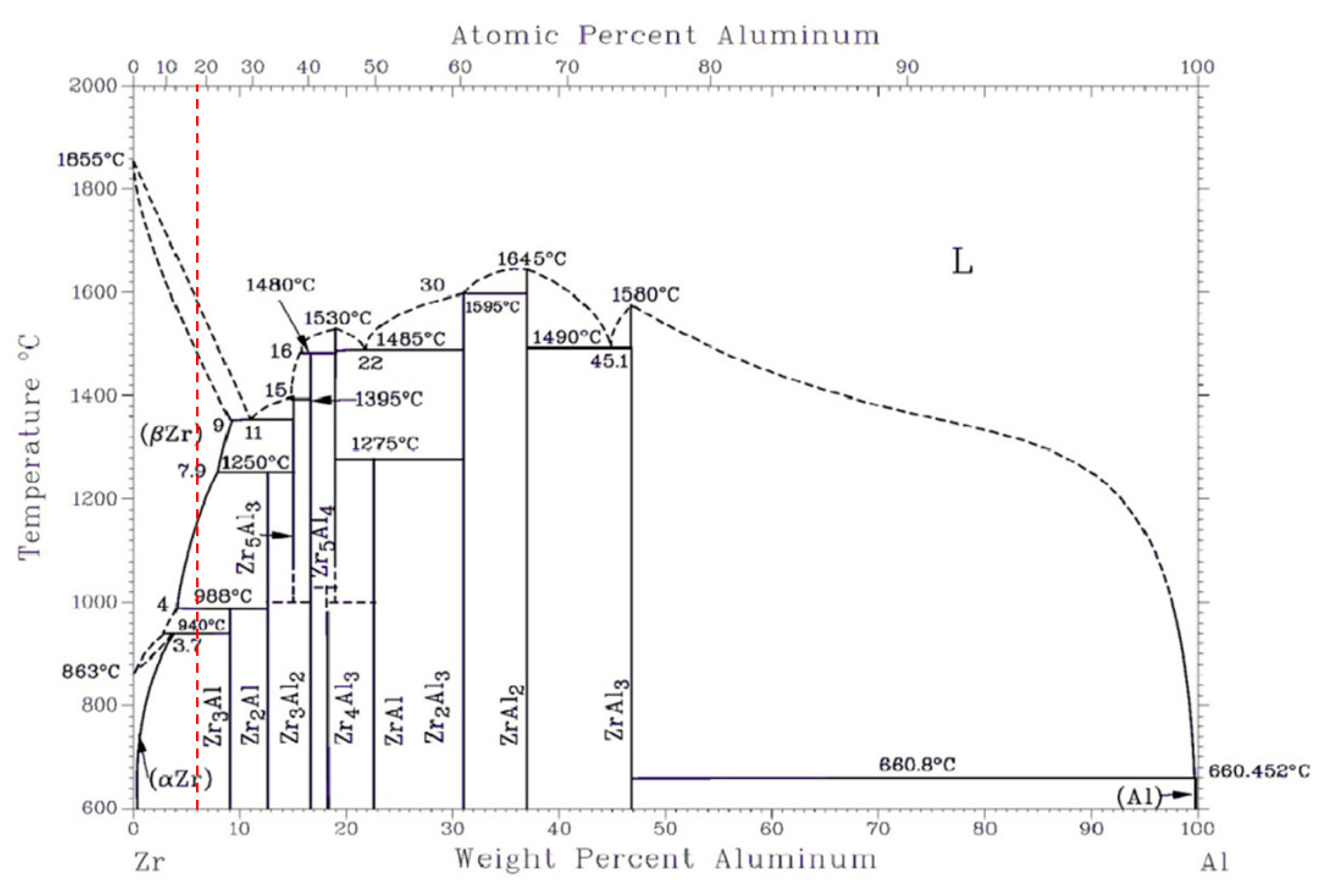
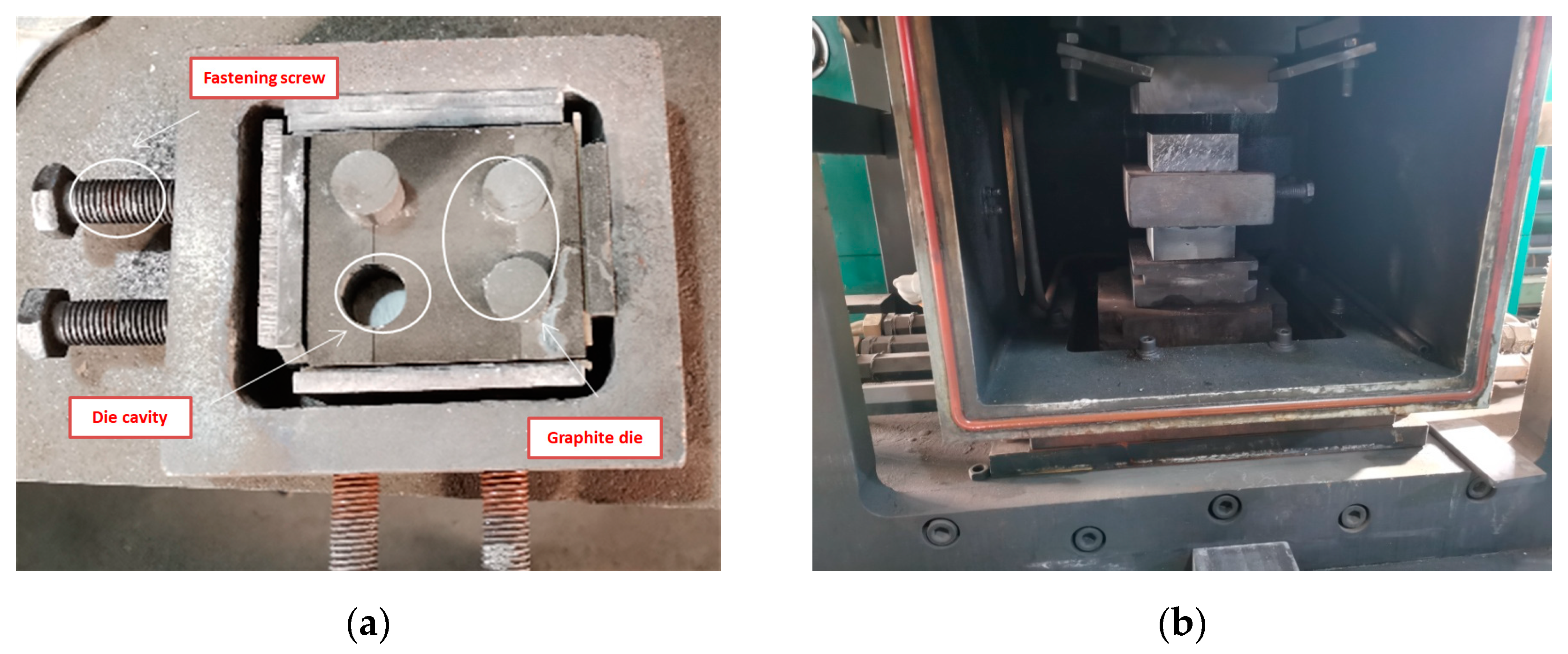

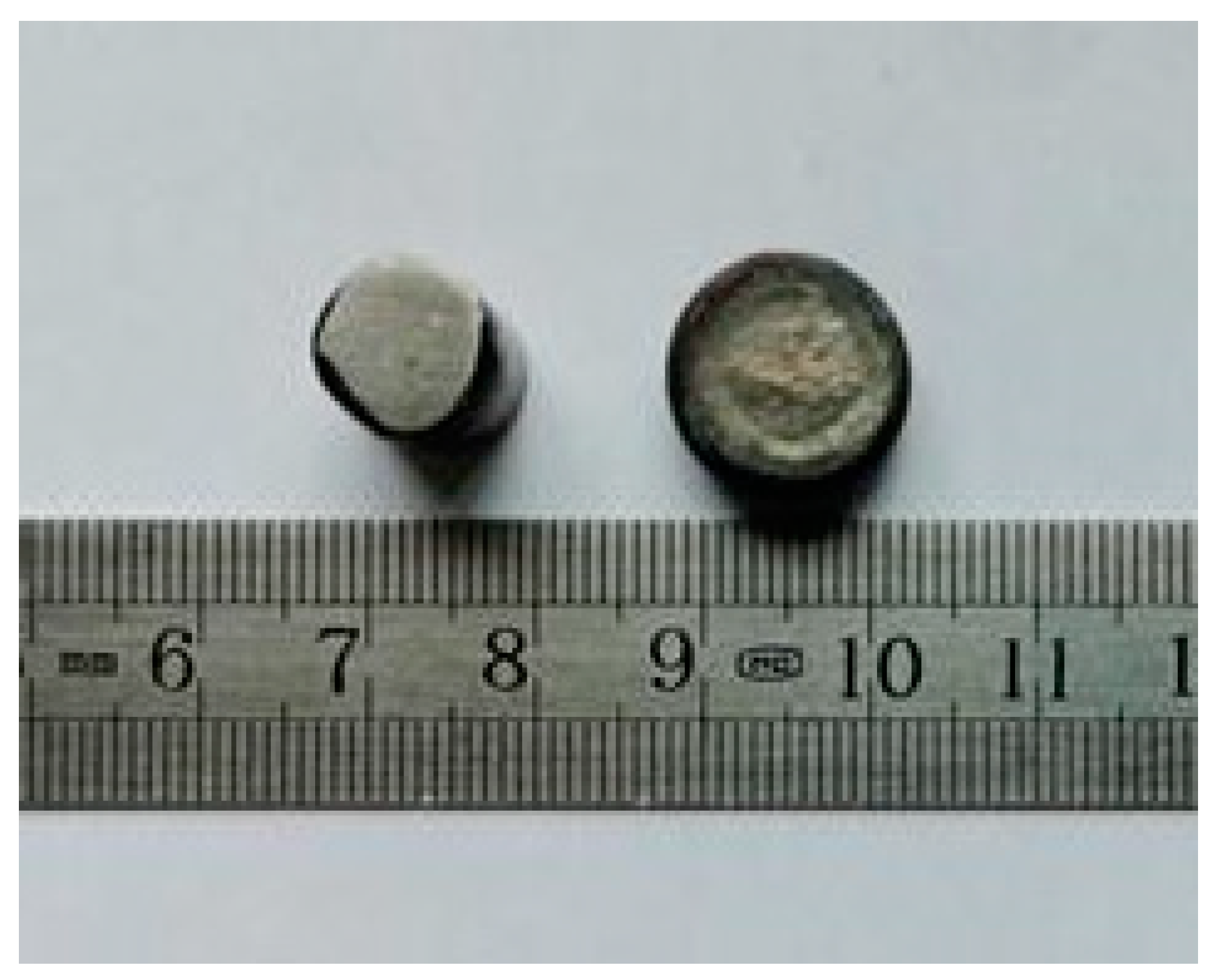
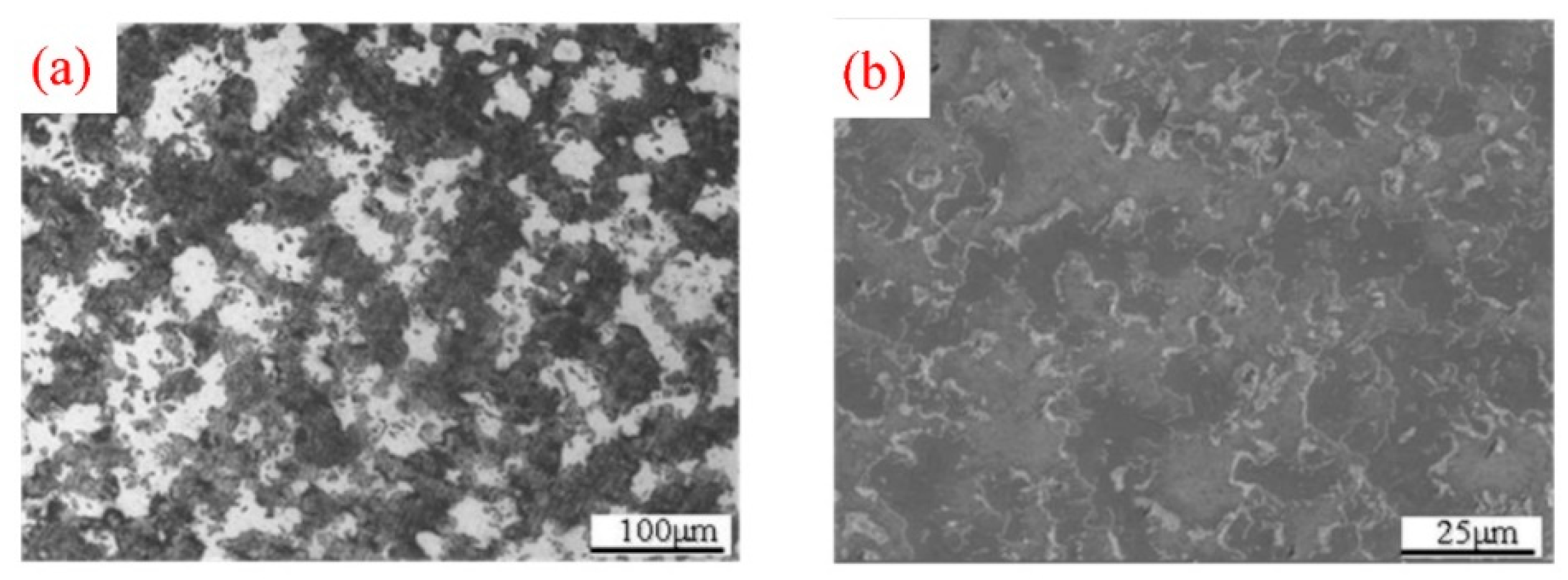

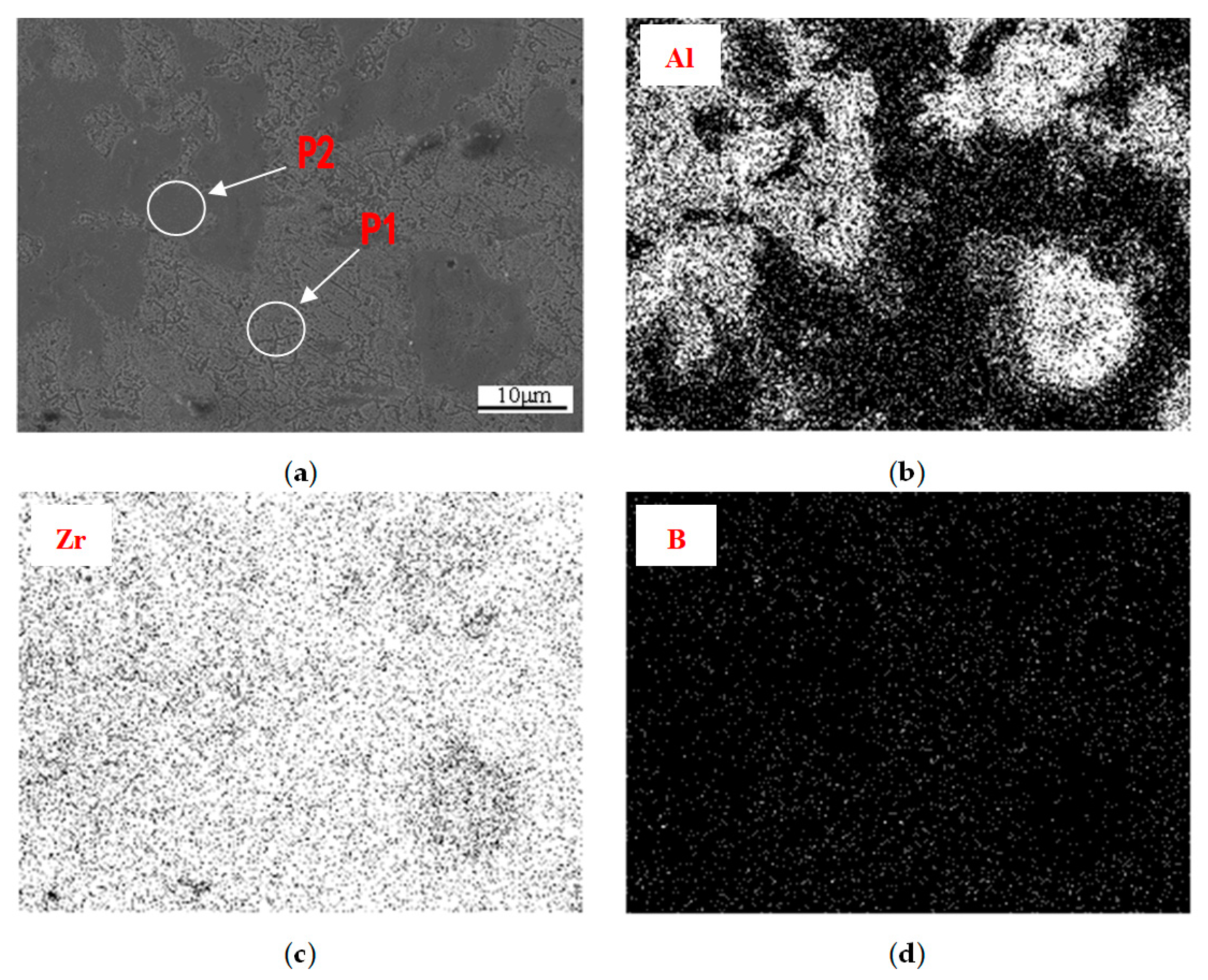

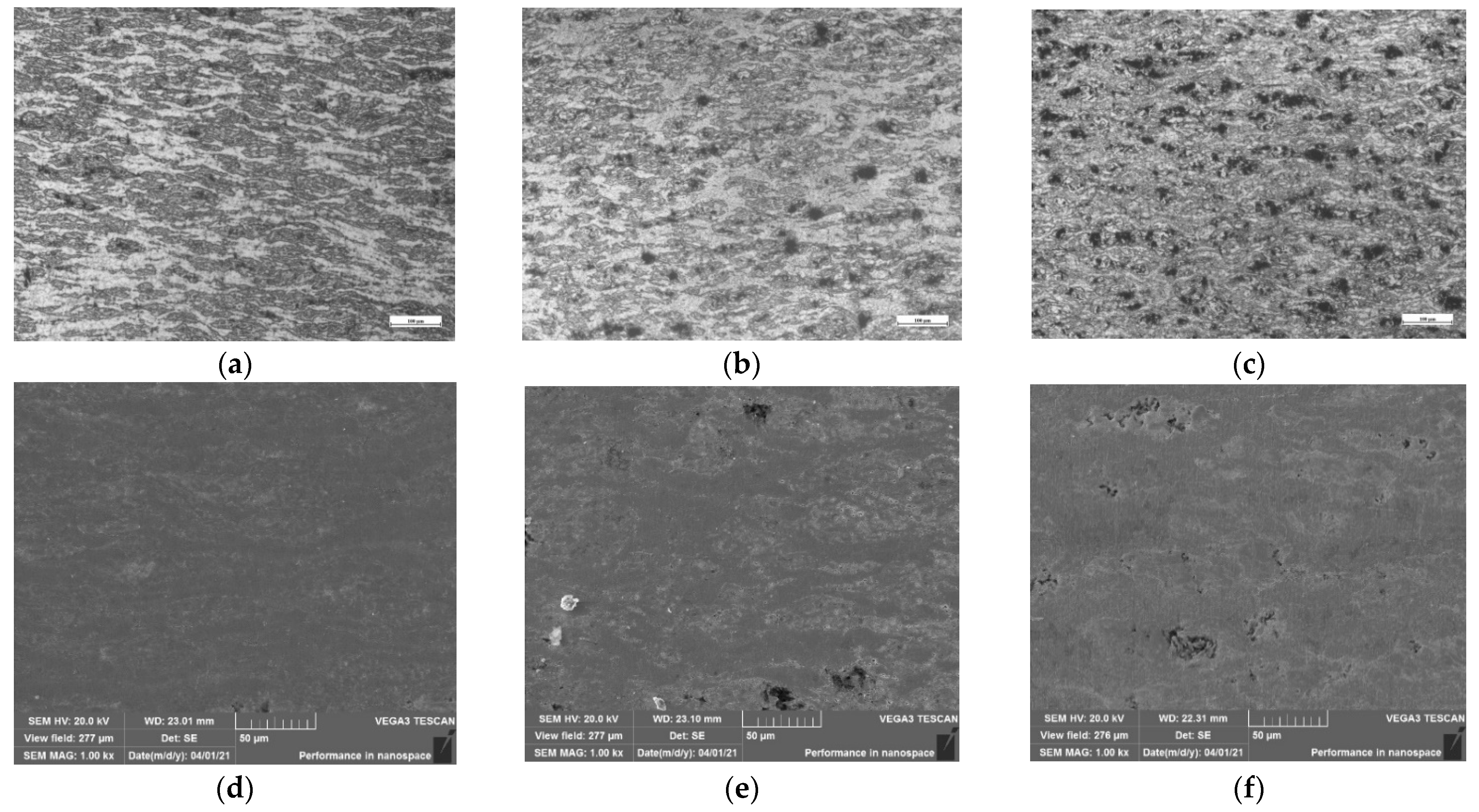
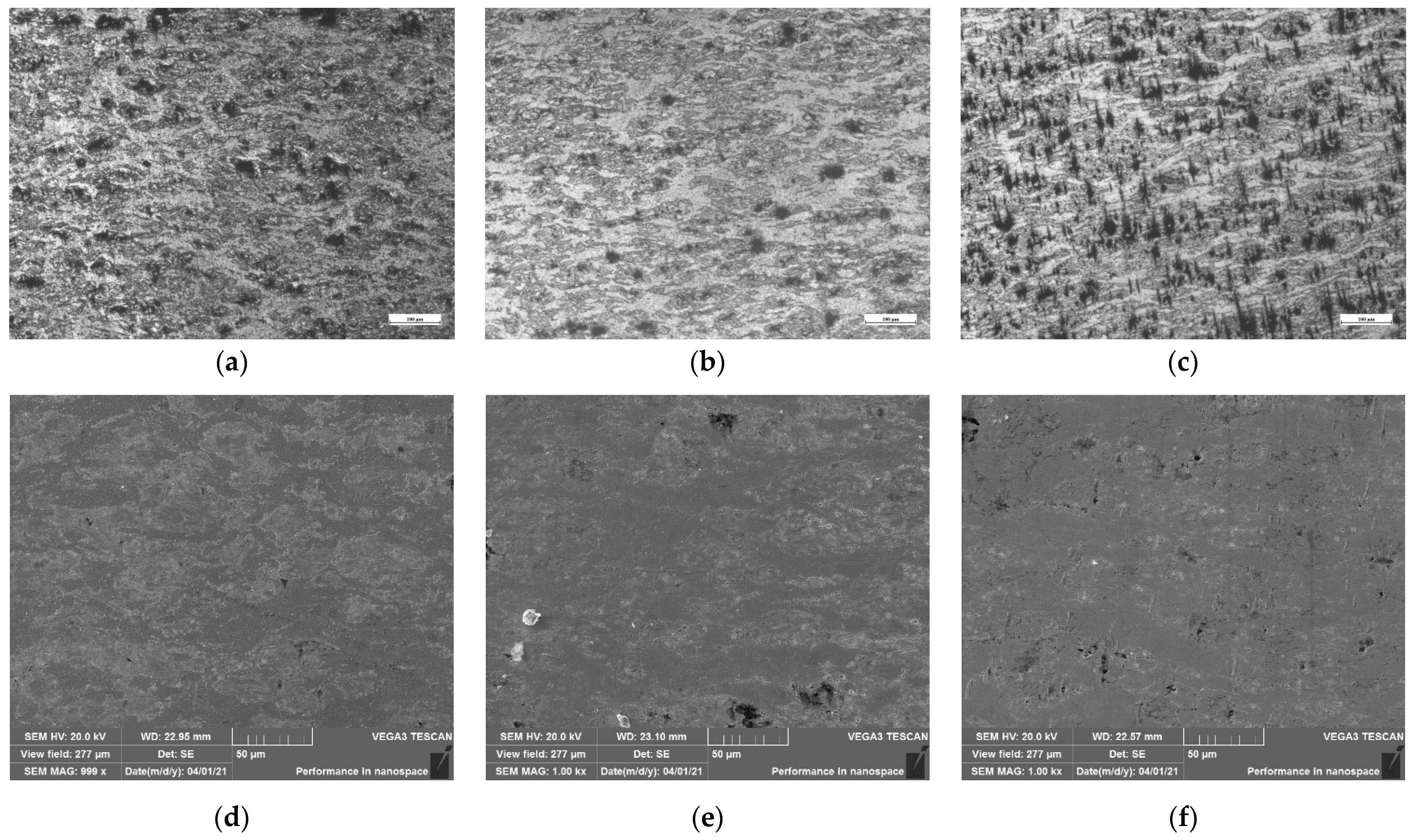
| Region | Zr | Al | B |
|---|---|---|---|
| P1 | 93.42 | 5.63 | 0.95 |
| P2 | 75.66 | 23.72 | 0.62 |
Publisher’s Note: MDPI stays neutral with regard to jurisdictional claims in published maps and institutional affiliations. |
© 2022 by the authors. Licensee MDPI, Basel, Switzerland. This article is an open access article distributed under the terms and conditions of the Creative Commons Attribution (CC BY) license (https://creativecommons.org/licenses/by/4.0/).
Share and Cite
Yan, H.; Wang, W.; Zhang, S.; Ma, S.; Li, J.; Wang, B. Microstructure and Thermal Deformation Behavior of Hot-Pressing Sintered Zr-6Al-0.1B Alloy. Materials 2022, 15, 1816. https://doi.org/10.3390/ma15051816
Yan H, Wang W, Zhang S, Ma S, Li J, Wang B. Microstructure and Thermal Deformation Behavior of Hot-Pressing Sintered Zr-6Al-0.1B Alloy. Materials. 2022; 15(5):1816. https://doi.org/10.3390/ma15051816
Chicago/Turabian StyleYan, Huajun, Wei Wang, Shuangjie Zhang, Shibo Ma, Jianhui Li, and Bo Wang. 2022. "Microstructure and Thermal Deformation Behavior of Hot-Pressing Sintered Zr-6Al-0.1B Alloy" Materials 15, no. 5: 1816. https://doi.org/10.3390/ma15051816





